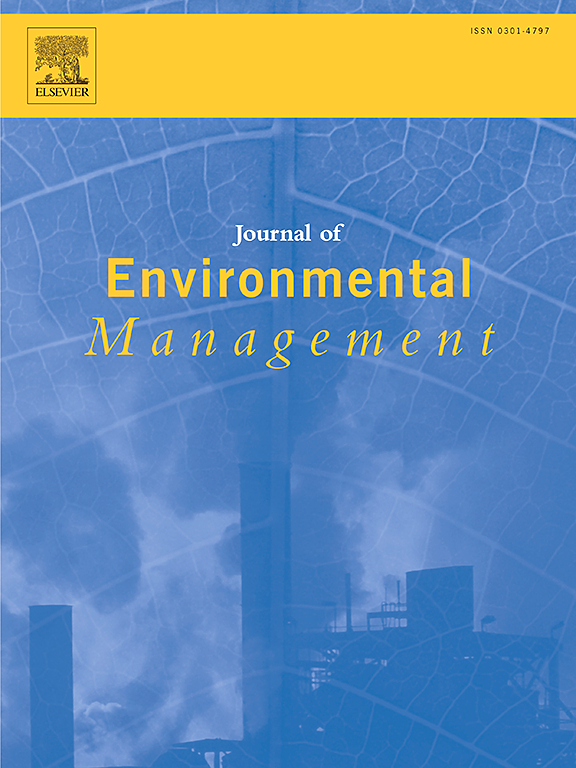生物甲烷化沼液中微藻的先进培养,最大限度地利用食物垃圾渗滤液
IF 8
2区 环境科学与生态学
Q1 ENVIRONMENTAL SCIENCES
引用次数: 0
摘要
由城市生活垃圾(即OFMSW或食物垃圾)的有机部分脱水得到的压滤渗滤液是一种高浓度有机物、浊度和颜色的酸性废水,难以处理,但具有很大的资源利用潜力。厌氧消化是一种众所周知的高效处理OFMSW渗滤液的方法,产生生物燃料(沼气)和液体消化液,富含营养物质和有机化合物,比OFMSW渗滤液更适合生物质转化。先进的微藻培养技术被认为是一种很有前途的技术,可以最大限度地利用食物垃圾压滤滤液(FWPD)的消化液(FWPD),但微藻在FWPD上的具体生长参数(如营养物质浓度、光、温度、pH等)尚不清楚。因此,采用正交试验设计,研究了不同参数对普通小球藻生长和FWPD养分利用的影响。在有机负荷(52.55、31.53和10.51 g VS·L−1)、光照强度(1000、2000和3000 Lux)和光周期(8、12和16 h) 3个水平上考察了3个主要影响因素。极差分析结果表明,52.55 g VS·L−1的有机负荷对微藻生物量产量、总叶绿素含量、总氮和总磷回收率影响最大。此外,有机负荷也是微藻生物量中蛋白质和碳水化合物积累的驱动因素,与光周期是主要因素的脂质积累相反。本研究结果为优化FWPD中微藻的培养提供了新的信息,并揭示了这一过程的机制。本文章由计算机程序翻译,如有差异,请以英文原文为准。

Advanced microalgal cultivation in biomethanation digestate to maximize resource utilization of food waste leachate
The pressed-off leachate obtained from the organic fraction of the municipal solid waste (i.e. OFMSW or food waste) dewatering, is an acidic wastewater with high concentrations of organic matter, turbidity, and color that is difficult to treat but has a significant resource utilization potential. Anaerobic digestion is a well-known and efficient treatment method of the OFMSW leachate, yielding a biofuel (biogas) and a liquid digestate, rich in nutrients and organic compounds, which is more suitable than the OFMSW leachate for biomass conversion. Advanced microalgae cultivation has been identified as a promising technology that could maximize resource utilization of digestate of pressed-off leachate from food waste (FWPD), however the specific microalgae growth parameters on FWPD (e.g. nutrient concentrations, light, temperature, pH, etc.), are still unclear. Thus, an orthogonal experimental design was used to assess the impacts of different parameters on Chlorella vulgaris growth and nutrients utilization from FWPD. Three major factors were investigated at three levels: organic loading (52.55, 31.53, and 10.51 g VS·L−1), light intensity (1000, 2000 and 3000 Lux) and photoperiod (8, 12 and 16 h). Range analysis results indicated that organic loading at 52.55 g VS·L−1 was the most influential factor on microalgal biomass yield, total chlorophyll content, total nitrogen and total phosphorus recovery. Additionally, organic loading was also the driving factor for protein and carbohydrate accumulation in microalgal biomass, contrary to lipid accumulation where photoperiod was the predominant factor. The results of this study are providing novel information for the optimization of microalgae cultivation in FWPD and shed light on understanding the mechanisms dictating the process.
求助全文
通过发布文献求助,成功后即可免费获取论文全文。
去求助
来源期刊

Journal of Environmental Management
环境科学-环境科学
CiteScore
13.70
自引率
5.70%
发文量
2477
审稿时长
84 days
期刊介绍:
The Journal of Environmental Management is a journal for the publication of peer reviewed, original research for all aspects of management and the managed use of the environment, both natural and man-made.Critical review articles are also welcome; submission of these is strongly encouraged.
 求助内容:
求助内容: 应助结果提醒方式:
应助结果提醒方式:


